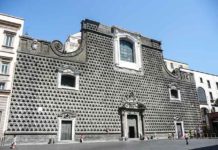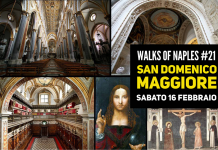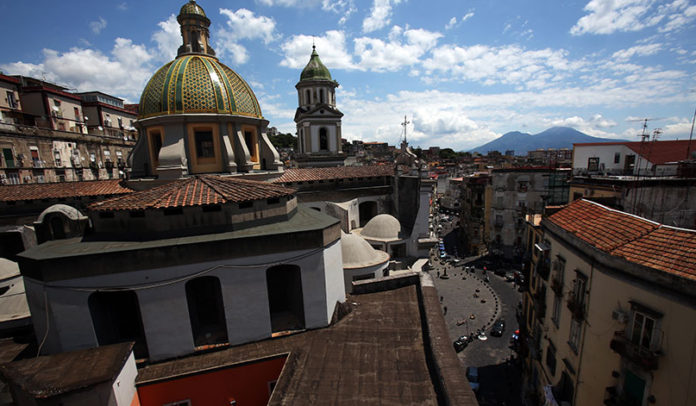
The Rione Sanità position in Naples has been considered particularly salubrious over the last centuries. It goes from Capodimonte down to the valley, in a succession of luxuriant vegetation and sources of water. There have always been legends of miracles and healings believed to have been granted through the intercession of the saints, who were buried there. Rich and noble families travelled along the obligatory path that the Royals used to use to reach the Royal Palace situated in the hills. They started competing to order to build the most amazing Baroque buildings such as the superb and theatrical Palazzo del Spagnolo or Palazzo Sanfelice.
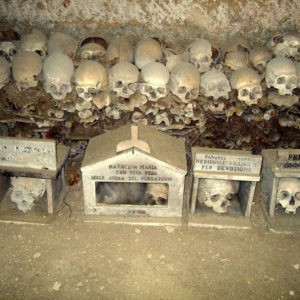 But such splendor did not last. First, the construction of the bridge and then that of the great mass grave, which had been created to contain the thousands of people decimated by continuous epidemics, eruptions, and famines. These were considered punishments and they fell at regular intervals on the city. These tragedies completely overwhelmed the laughing face of the Neighborhood. The subsoil was layered with the dead, from the early Christian catacombs to the Fontanelle cemetery. Eventually, the corpses of the dead were mixed, those of the epidemics with the poor who could not afford another burial place beyond the gigantic tufa quarry. Those unearthed from churches, togetherwith those of the revolts and earthquakes, were put together. The catacombs of San Gaudioso were reopened and reused by the Dominican friars for burials. The soil was sold at a very high price to those who wanted a privileged path directly to heaven. By procuring a tomb in a sacred place, plus the draining of the body, a macabre treatment of the corpse that would have purified the remains, “granted” the dead a discount in Purgatory.
But such splendor did not last. First, the construction of the bridge and then that of the great mass grave, which had been created to contain the thousands of people decimated by continuous epidemics, eruptions, and famines. These were considered punishments and they fell at regular intervals on the city. These tragedies completely overwhelmed the laughing face of the Neighborhood. The subsoil was layered with the dead, from the early Christian catacombs to the Fontanelle cemetery. Eventually, the corpses of the dead were mixed, those of the epidemics with the poor who could not afford another burial place beyond the gigantic tufa quarry. Those unearthed from churches, togetherwith those of the revolts and earthquakes, were put together. The catacombs of San Gaudioso were reopened and reused by the Dominican friars for burials. The soil was sold at a very high price to those who wanted a privileged path directly to heaven. By procuring a tomb in a sacred place, plus the draining of the body, a macabre treatment of the corpse that would have purified the remains, “granted” the dead a discount in Purgatory.
The healthy land became an immense cemetery. The nobles gradually left. The great buildings were transformed into public housing and the market stalls found shelter in their immense doorways. The building of the bridge had cut the neighborhood out of the city, leaving it isolated. The Sanità had become an island. The humble people who were settling there created legends, cults and rites around death, with which they lived so intimately. It was the other side of life, with which to form an alliance with, to take advantages from. Unabling to expect help from the living, the people asked it from the dead. Thus the Fontanelle Cemetery became a sort of “Stargate”, between the Earth and the world of the dead. The people decided to adopt these “Anime Pezzentelle”, “poor souls”. Poor especially because they were orphans, without a name or family. People used to choose a skull, “‘na capuzzella”, which was considered as one of the family, but with miraculous abilities. This meant, however, that it had to be polished, placed on embroidered handkerchiefs, adorned with candles and flowers, giving it a name and a story.
From these stories were born the legends which are about some of the most famous Capuzzelle. These go from a Captain, a vengeful soldier. Another is about Friar Pasquale, who gives lottery numbers, to Donna Concetta, “the skull which sweats”. This skull is said to answers the prayers of those whose hand becomes damp when touching the skull.
But, in order to meet “the poor soul” in a dream, and to ask them for graces, it was necessary to give them “rifrisco”, that is relief, with prayers and suffrages. If these graces were granted, the skull would be honored by building it a kind of tabernacle made from the most diverse materials, from biscuit tins to marble, according to the person’s economic possibilities. If the grace was not granted, the skull would be abandoned and replaced with another. For a very long time, the Neapolitans took care of the “Anime Pezzentelle”: it did not matter if those remains belonged to strangers whose names had been forgotten over the centuries. Because every Neapolitan of the past is an ancestor of today’s Neapolitans. And until there is always someone that takes care of it, no one will be truly ever forgotten.
In the center of the square, there is a basilica whose dome of green majolica can be seen from almost all of Naples: Santa Maria alla Sanità, a great work of art by Fra Nuvolo. It is the place where one can still seem to see the plague victims praying. It arose there because it was a natural confinement. It is grandiose, but yet scarn. With its imposing marble staircases that rise upwards, it is a place where all the pain and hope of the people of the time seemed to have converged. It is the burial place of St. Vincent whose statue, while being carried in procession, interrupted the cholera epidemic.
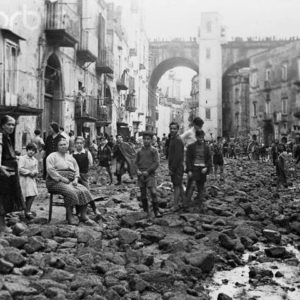 Everything is made of tuff, in the Sanità. From the hills, flows “the Lava of the Virgini”, that is water and mud. It has eroded the area for thousands of years, creating the right conditions for its extraction. The catacombs were excavated from this raw material and with it the above buildings were built.
Everything is made of tuff, in the Sanità. From the hills, flows “the Lava of the Virgini”, that is water and mud. It has eroded the area for thousands of years, creating the right conditions for its extraction. The catacombs were excavated from this raw material and with it the above buildings were built.
This is the element that physically connects the living and the dead, the one that permits the eternal dialogue that this neighborhood has with the afterlife.
The social and cultural isolation in which it was confined, served as a protection to modernity. A district where for many years the atmosphere of the De Filippo’s “Mayor of the Sanità district”, has survived compared to the new and cruel Gomorra of Scampia.
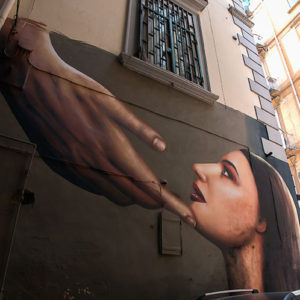 Today, by accessing Via dei Vergini, among the colorful stalls of the flourishing market next to the beautiful baroque buildings, there is a district in full rebirth. International artists are decorating the whole district with wall artworks and colorful Street art. Many, are the festivals and the white nights held here, and tourists are now discovering this immense heritage, which is also gastronomic. Here is possible to taste the best bread, desserts and pizzas of the whole city. In Via Santa Maria Antesaecula, can be found a gigantic drawing of Totò, who took inspiration from the faces of the people of the district to create his characters. Numerous films were filmed in this neighborhood, which is a true open-air set. When I looked for the place to set my novels, I could not choose but this one.
Today, by accessing Via dei Vergini, among the colorful stalls of the flourishing market next to the beautiful baroque buildings, there is a district in full rebirth. International artists are decorating the whole district with wall artworks and colorful Street art. Many, are the festivals and the white nights held here, and tourists are now discovering this immense heritage, which is also gastronomic. Here is possible to taste the best bread, desserts and pizzas of the whole city. In Via Santa Maria Antesaecula, can be found a gigantic drawing of Totò, who took inspiration from the faces of the people of the district to create his characters. Numerous films were filmed in this neighborhood, which is a true open-air set. When I looked for the place to set my novels, I could not choose but this one.
Who is Annavera Viva

Annavera Viva, author of the “pen fresco” on the Rione Sanità, was born in Galatina (Lecce) but has lived in Naples since 1982. She is the author of numerous stories, many of which are finalists in national and international literary prizes. These include A high concept of dignity, published in the Iter fati collection (Publisher Eris, Turin), for which she received the special mention of the jury as part of the literary prize “Racconti Corsari” (2013). With Questions of Blood (Homo Scrivens 2014), a novel in which Raffaele and Peppino appear for the first time, the two brothers separated at birth and destined to trave opposite roads, this has met with success with the public and critics. Chimere (Homo Scrivens 2015), her second mystery novel, is always set in the Rione Sanità in Naples, with the protagonists Father Raffaele and don Peppino. Her third novel is about to be published, and this is also set in the Rione Sanità.

 Italiano
Italiano

